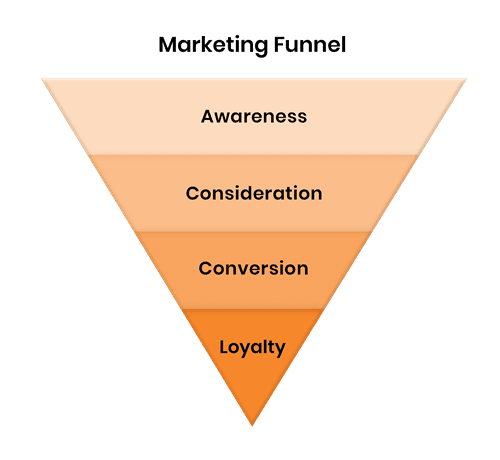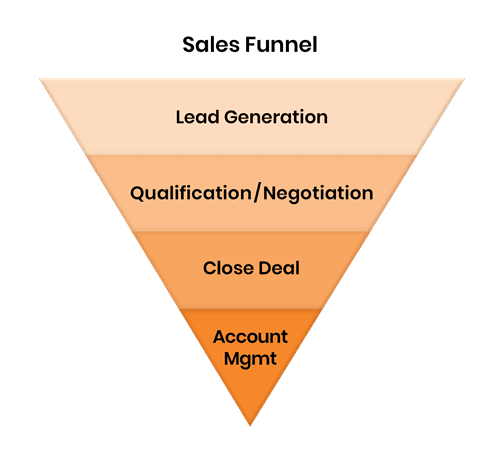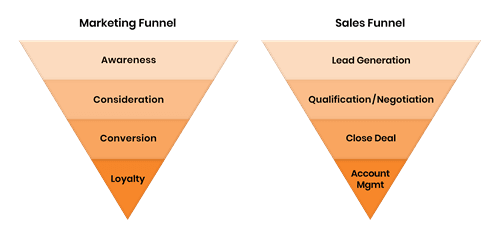
Questions?
Let our experts help you grow your business.
CONTACTResources
What’s the Difference Between a Marketing Funnel and Sales Funnel?
Marketing Funnels Vs. Sales Funnels
You’ve probably heard the phrases marketing funnel and sales funnel, and sometimes they are used interchangeably. While they are very similar in nature, they are actually two different tools that, when optimized and properly integrated, can significantly maximize your conversions. One simple way to look at it is the marketing funnel focuses on customer interactions with your brand, while the sales funnel focuses on customer interactions with your people.
Both funnels play a critical role in the customer journey from awareness through conversion (and beyond), each having their own specific objectives as they work together to create a comprehensive sales and marketing strategy.
This white paper clarifies the difference between these two similar tools, and helps explain how to optimize both to create sales and marketing funnels that work seamlessly together to increase your revenue.
What is a Marketing Funnel?
A marketing funnel defines the stages of a customers’ personal journey and their interactions with your brand as they move from initial brand awareness to conversion and loyalty. It serves as a visual map to guide them through the stages. Keep in mind that customers can jump in and out of the marketing funnel at different points, and even cycle through it several times before making a final decision.
Stages of a Marketing Funnel

Awareness: Prospects become aware of your brand through various channels like social media, online ads, blog posts, search engines, etc. You’re planting the seed here! Get noticed with attention-grabbing ads and creative content that inspires interest in your brand.
Consideration: Potential customers actively consider your product or service as a solution to their needs. Your brand is being evaluated and compared competitors. Differentiate your brand by highlighting your unique features on various channels and through personalized communication. Establish your brand as a credible authority with informative, interactive content like webinars, demonstrations, and white papers.
Conversion: In this stage, prospects take a desired action, like making a purchase or signing up for a service. Eliminate lingering doubt by featuring customer feedback and testimonials showcasing positive experiences. Encourage conversion with free trials, personalized incentives, and secure, simplified checkout processes.
Loyalty: In this post-purchase stage, the goal is to build a lasting relationship, encouraging repeat business and advocacy. Ensure a positive customer experience with helpful follow-ups like tutorials and links to important FAQs. Inspire advocacy and retention with exclusive incentives, rewards programs, and personalized promotions.
Marketing Funnel Tactics
Marketing funnels use a variety of tactics to engage with the customer throughout their journey. Some tactics can be tailored for each stage of the funnel, but it’s important to employ a variety of tactics and channels to promote your brand and stay in your customer’s line of sight.
Data-driven insights help optimize your funnel. Conduct regular evaluations to see how and where your customers are engaging with your brand. Identifying customer behavior patterns can help you reallocate resources where they are most valuable.
SEO (Search Engine Optimization): Attract organic traffic, nurture leads, and increase conversions by creating valuable content with relevant keywords. Improve visibility by tracking performance and refining your strategy as needed.
Retargeting Ads: Target users who have interacted with your brand, but not yet converted. Tailor your ads for each funnel stage to address specific needs, and use dynamic creatives to re-engage potential customers.
Events & Tradeshows: In-person events are lead-generating opportunities! Use engagement activities to capture information and follow up with personalized content.
Social Media: Attract and engage potential customers with platform-specific content. Social proof, influencers, and retargeting ads guide leads through the consideration phase, while time-sensitive offers and user-generated content encourage conversions.
Email Marketing & Newsletters: Segment your audience by their stage in the customer journey and deliver personalized content. Nurture leads with drip campaigns featuring valuable insights, product updates, and special offers. Post-purchase, deliver targeted follow-ups and exclusive deals to build loyalty and encourage repeat business.
Blogs & Infographics: Create informative, keyword optimized content to attract and educate customers. Infographics are ideal for visually summarizing unique features, while blogs are great for addressing pain points. Drive engagement and conversions by sharing these valuable assets across multiple channels.
Videos: Use engaging and informative video content that aligns with each stage of the funnel. Share these useful resources across platforms to capture attention and nurture leads.
Live Chats, Demonstrations, & Webinars: These are great resources for offering real-time interaction and personalized solutions. Take this opportunity to showcase product value, address lingering questions and pain points, and build trust with your potential client base.
Remember! Review each stage of the marketing funnel and evaluate the performance metrics of each tactic. Optimize and refine your strategies as needed to ensure you’re getting the most value out of your efforts.

What is a Sales Funnel?
A sales funnel focuses on interactions between your sales team and prospects, guiding them from the problem awareness stage to making a purchase. It involves nurturing leads through personalized communication, addressing their needs and pain points, and building trust to convert them into customers. The goal is to move prospects efficiently through each stage of the buying process, ultimately leading to a successful sale.
Stages of a Sales Funnel

Marketing Qualified Leads (MQL) - MQLs have demonstrated interest and engaged with your marketing content, signaling they are ready for a more direct sales approach. These leads have moved beyond the awareness stage in the sales funnel and are considering your solutions. MQLs are passed to the sales team for added nurturing and nudged towards conversion.
Sales Accepted Lead (SAL) - SALs have been passed from marketing to the sales team and accepted based on predefined qualification criteria. Collaboration between marketing and sales is crucial to ensure a smooth transition, as it aligns both teams on lead quality and readiness. This cooperation maximizes the odds of conversion.
Sales Qualified Lead (SQL) - SQLs have been vetted by the sales team and are deemed ready for direct sales interaction and a proposal. These leads are in the final stages of the sales funnel, having demonstrated strong intent to purchase. Shift your focus to closing the deal through personalized offers and negotiations.
Sales Funnel Tactics
Sales funnel tactics are essential strategies designed to guide prospects through each stage of the buyer's journey, from initial awareness to final conversion. When these tactics are applied effectively, businesses can nurture leads, build relationships, and increase the chances of closing deals. Understanding and implementing key techniques like direct outreach, personalized emails, and product demos helps streamline the process and improves overall sales performance.
CRM tools are essential for tracking leads through the sales funnel, helping organize information, automate follow-ups, and analyze interactions. They help sales teams prioritize efforts, stay engaged, and improve lead conversion rates.
Direct Outreach – Reach out to possible leads through calls, emails, or social media to generate interest and build real connections.
Personalized Email Sequences – Create tailored email campaigns based on lead behavior and funnel stage to nurture relationships. Drip campaigns are great for keeping your brand top of mind.
Demos – Offer product or service demonstrations to showcase value and address any concerns or questions potential customers may have.
Sales Calls – Engage prospects with one-on-one calls to better understand their needs and guide them through the funnel.
Retargeting Ads – Use ads to re-engage leads who have shown interest but haven't yet converted.
Lead Scoring – Prioritize leads based on levels of engagement and readiness to help the sales team focus on the most promising prospects.
Negotiation Strategies – Use tailored negotiation strategies to address objections and secure deals during the decision stage.
Case Studies and Testimonials – Present success stories and customer reviews to build trust and provide social proof.
Key Differences Between Marketing Funnels & Sales Funnels
Sales funnels are business-focused, serving as an internal guide for sales and marketing teams, outlining the steps needed to keep prospects moving from leads to paying customers. In contrast, marketing funnels are customer-focused, examining the entire customer journey from the moment they become aware of a brand to making a purchase and beyond. While sales funnels focus on guiding customers through the buying process, marketing funnels are designed to reflect how customers prefer to buy, not how the business wants to sell.
Here are 9 differences between marketing funnels and sales funnels:
- Focus: In the marketing funnel, the focus is on attracting and educating potential leads, while the sales funnel emphasizes nurturing and converting them into customers.
- Stages: The marketing funnel typically puts more emphasis on awareness and consideration stages, while the sales funnel handles consideration through decision and purchase stages.
- Metrics: Marketing funnel metrics measure impressions, clicks, and engagement, while sales funnels are best to track conversion rates, deal size, and win rates.
- Goals: Marketing funnels aim to generate and qualify leads, while sales funnels aim to close deals and drive revenue.
- Outreach Methods: Marketing funnels use mass outreach tactics like ads and content, while sales funnels utilize more personalized methods such as direct outreach and sales calls.
- Timing: Marketing funnels engage leads over a longer period to build interest, while sales funnels interact with leads closer to conversion, focusing on a shorter time frame.
- Defined Audience: Marketing funnels targets a broad audience, using engagement and brand awareness to capture potential leads, while sales funnels focus on a narrower, more qualified audience, with an emphasis on individual prospects that are ready for more direct interaction.
- Ad Spend: Marketing funnels typically allocate budgets for brand awareness and lead generation, whereas sales funnels spend less on ads, focusing more on direct engagement.
- Follow-up Process: Marketing funnel follow-ups nurture leads through automation and content, while sales funnel follow-ups address specific objections and close deals.

Improve Your Sales & Marketing ROI via Funnel Optimizations
Simply put, marketing funnels generate leads, while sales funnels turn marketing qualified leads into paying customers. When optimized, marketing and sales funnels work together to seamlessly transition prospects from initial brand awareness to consideration and finally to a purchase. Marketing attracts and nurtures leads with education and engagement, while sales provides personalized interactions, addresses objections, and closes deals. Together, they ensure a smooth journey that builds trust and encourages long-term loyalty.
Ready to take your business to the next level? Start optimizing your marketing and sales funnels today and watch your leads turn into loyal customers! Schedule a free consultation with the experts at MatrixPoint.
